Multifunctional Inhibitors: Additives to Control Corrosive Degradation and Microbial Adhesion
Abstract
1. Introduction
2. Corrosion
2.1. Types of Corrosion
2.2. Inhibition of Corrosion
- Anodic type (passivators, film formation on the metal surface; it prevents the oxidation reaction, nitrates, molybdates, etc.);
- Cathodic inhibitors: they reduce the cathodic reactions; zinc, aluminum and their alloys;
- Volatile corrosion inhibitors: they release a vapor that protects the metal surface temporarily; organic acids, amines, carboxylates;
- Film-former inhibitors: a protective barrier film is formed on the metal surface that keeps the corrosive environment far from the solid metal; surfactants, amines, phosphates;
- Biocide type: in the presence of corrosion relevant microbes, these chemicals can control the microbial life (growth, multiplication, metabolite secretion); hypochlorite, chlorine dioxide, formaldehyde, glutaraldehyde, quaternary ammonium compounds, etc.
3. Corrosion Control by Inhibitors
- The environment of the instrument where they will be used: temperature, pH, humidity, aggressive ions and molecules—they should be compatible with the inhibitors;
- The compatibility of the structural material with the inhibitor used for protection;
- The corrosion mechanisms: this is a crucial factor as it determines the proper selection of inhibitors to structural metals; it is influenced by the type of corrosion (general, pitting, crevice, etc.) that can deteriorate metals;
- The cost of inhibitors and their availability;
- The environmental impact: the health restrictions should always be considered.
Types of Inhibitors [4]
4. Corrosion Control by Coatings
5. Corrosion Monitoring
- Electrochemical corrosion of metals: electrons from the surface metal atoms are formed and then transferred to electron acceptors (oxygen, acids, etc.) in the presence of water. This is a hybrid process when the chemical state of metal atoms is transformed to metal ions and then the metal valence electrons are transferred to electrochemically active ions/molecules [24].
- Chemical corrosion: in this case, the presence of an external environment causes a gradual destruction of metals, e.g., the oxidation/dissolution of metals via acids. electron transfer is not necessary.
- Microbiologically influenced corrosion (MIC) [25]; the reactions caused by microbes that deteriorate metals are due to chemical or electrochemical processes. The presence of microorganisms such as bacteria, fungi and algae in the environment can especially enhance the corrosion when they are embedded in biofilms.
6. Microbiologically Influenced Corrosion
6.1. Corrosion Relevant Microorganisms
6.2. Biofilms
- Metal/solution interface: chemical composition, concentration of components (organic, inorganic ions, pH), thickness of the passive film, roughness, polarization;
6.3. Inhibition of MIC
- Physical treatment: removal of already developed biofilms;
- Electrochemical methods, e.g., cathodic protection;
- Chemical treatment: application of several chemicals (oxidizers, non-oxidizers, membrane active, chelate formers, etc.);
- Biological resolution: in this technique, microorganisms are used to control the biofilm formation, and this is called microbially controlled corrosion inhibition (MICI).
6.4. MIC Inhibition by Chemicals
7. Multifunctional Chemicals with Anticorrosion and Antimicrobial Activity
- Chemicals efficient mainly in affecting microbial life as well as they have anticorrosion activity, too: quaternary ammonium compounds (control of microbial growth and corrosion, applied especially on copper and iron alloys as they form protective films on metal surfaces; reduction in microbial adhesion and corrosion); cetyl pyridinium bromid; izothiazolinon derivatives (with antimicrobial activity of broad-spectrum, mainly applied in the cooling industry); benzalkonium chloride (it forms a protective layer that reduces the corrosion and controls the microbial growth);
- Multifunctional organic inhibitors: imidazolines (applied mainly in the gas and oil industry), amines: cyclohexyl amine, morpholine and other amines;
- Polymeric biocides: poly-quaternary ammonium compounds (they control both corrosion and microbial attachment as well as the formation of biofilms) and chitosan, a renewable marine polymer (film-forming, protection against corrosion and microbial adhesion) [32];
- Combination of biocides: the parallel application of different biocides often results in a synergistic effect (e.g., thymol and benzyldimethyl-dodecylammonium chloride) that could control a microbial diversity in marine environments [33].
8. MIC Inhibition by Coatings
- Slippery liquid-infused porous surfaces show anticorrosion and anti-fouling activity. They consist of porous solid substrates and lubricant oil. This system can cover a metal surface and repel not only the corrosive chemical species but also microorganisms, because of the surface lubricant layer [41]. The explanation of the antibacterial activity is that the fatty acid in the oil will destroy the cell membrane;
- Superhydrophobic or superamphiphobic coatings: they are inspired by nature and their activity depends on special wettability properties [42];
- Silver-based antimicrobial coatings: the silver nanoparticles incorporated into coatings can regulate the microbial adhesion and biofilm formation; these special coatings have anticorrosion activity too.
9. Anticorrosion, Antimicrobial, Antifouling Coatings
9.1. Biocide-Based Antifouling Paint
9.2. Nanolayers for Controlling MIC and Corrosion Parallel [31,43]
10. Some Techniques Used for Monitoring MIC [44]
11. Summary
Funding
Conflicts of Interest
References
- Maji, K.; Lavanya, M. Microbiologically Influenced Corrosion in Stainless Steel by Pseudomonas aeruginosa: An Overview. J. Bio- Tribo-Corros. 2024, 10, 2024. [Google Scholar] [CrossRef]
- Available online: https://en.wikipedia.org/wiki/Intergranular_corrosion (accessed on 30 July 2023).
- Available online: https://en.wikipedia.org/wiki/Selective_leaching (accessed on 30 July 2021).
- Dariva, C.G.; Galio, A.F.; Dariva, C.G.; Galio, A.F. Corrosion Inhibitors–Principles, Mechanisms and Applications. In Developments in Corrosion Protection; IntechOpen: London, UK, 2014. [Google Scholar] [CrossRef]
- Shaban, A.; Vastag, G.; Telegdi, J. Chapter 2. Metal Corrosion and Its Inhibition Mechanisms: An Overview. In Corrosion Inhibitors: An Overview, 2021st ed.; Nova Science Publishers, Inc.: Hauppauge, NY, USA, 2021; Chapter 2. [Google Scholar] [CrossRef]
- Balangao, J.K.B. Corrosion of Metals: Factors, Types and Prevention Strategies. J. Chem. Health Risks JCHR 2024, 14, 79–87. [Google Scholar]
- Telegdi, J. Chapter 3-History of phosphorus-containing corrosion inhibitors: From the beginning till the present time. In Water-Formed Deposits; Amjad, Z., Demadis, K.D., Eds.; Elsevier: Amsterdam, The Netherlands, 2022; pp. 49–68. [Google Scholar] [CrossRef]
- Finšgar, M.; Milošev, I. Inhibition of copper corrosion by 1,2,3-benzotriazole: A review. Corros. Sci. 2010, 52, 2737–2749. [Google Scholar] [CrossRef]
- Chen, Y.; Yang, W. Formulation of Corrosion Inhibitors. In Water Chemistry; Eyvaz, M., Yüksel, E., Eds.; IntechOpen: London, UK, 2020. [Google Scholar] [CrossRef]
- Palanisamy, K.; Devabharathi, V.; Sundaram, N.M. Corrosion inhibition studies of mild steel with carrier oil stabilized of iron oxide nanoparticles incorporated into a paint. Int. J. ChemTech Res. 2015, 7, 1661–1664. [Google Scholar]
- Obot, I.; Umoren, S.; Johnson, A. Sunlight-mediated synthesis of silver nanoparticles using honey and its promising anticorrosion potentials for mild steel in acidic environments. J. Mater. Environ. Sci. 2013, 4, 1013–1018. [Google Scholar]
- Migahed, M.A.; Azzam, E.M.S.; Morsy, S.M.I. Electrochemical behaviour of carbon steel in acid chloride solution in the presence of dodecyl cysteine hydrochloride self-assembled on gold nanoparticles. Corros. Sci. 2009, 51, 1636–1644. [Google Scholar] [CrossRef]
- Atta, A.; EL-Mahdy, G.; Al-Lohedan, H.; Al-Hussain, S. Application of Eco-friendly Magnetite Nanoparticles Coated with Rosin Amidoxime as Corrosion Inhibitor for Mild Steel in 1 M Hydrochloric Acid Solution. Int. J. Electrochem. Sci. 2015, 10, 2621–2633. [Google Scholar] [CrossRef]
- Zheng, Z.; Schenderlein, M.; Huang, X.; Brownbill, N.J.; Blanc, F.; Shchukin, D. Influence of Functionalization of Nanocontainers on Self-Healing Anticorrosive Coatings. ACS Appl. Mater. Interfaces 2015, 7, 22756–22766. [Google Scholar] [CrossRef] [PubMed]
- Keyvani, A.; Yeganeh, M.; Rezaeyan, H. Application of mesoporous silica nanocontainers as an intelligent host of molybdate corrosion inhibitor embedded in the epoxy coated steel. Prog. Nat. Sci. Mater. Int. 2017, 27, 261–267. [Google Scholar] [CrossRef]
- Rigó, T.; Mikó, A.; Telegdi, J.; Lakatos-Varsányi, M.; Shaban, A.; Kálmán, E. Inhibition Effect of Hydroxamic and Phosphonic Acids Langmuir-Blodgett Films on Iron Corrosion in Sodium Perchlorate Solution. Electrochem. Solid-State Lett. 2005, 8, B51–B54. [Google Scholar] [CrossRef]
- Nazeer, A.A.; Madkour, M. Potential use of smart coatings for corrosion protection of metals and alloys: A review. J. Mol. Liq. 2018, 253, 11–22. [Google Scholar] [CrossRef]
- Nguyen-Tri, P.; Nguyen, T.A.; Carriere, P.; Xuan, C.N. Nanocomposite Coatings: Preparation, Characterization, Properties, and Applications. Int. J. Corros. 2018, 2018, 4749501. [Google Scholar] [CrossRef]
- Mansfeld, F. Analytical Methods in Corrosion Science and Engineering; Marcus, P., Mansfeld, F., Eds.; CRC Publisher: Boca Raton, FL, USA, 2006. [Google Scholar] [CrossRef]
- Collazo, A.; Nóvoa, X.R.; Pérez, C.; Puga, B. The corrosion protection mechanism of rust converters: An electrochemical impedance spectroscopy study. Electrochim. Acta 2010, 55, 6156–6162. [Google Scholar] [CrossRef]
- Telegdi, J. Formation of Self-Assembled Anticorrosion Films on Different Metals. Materials 2020, 13, 5089. [Google Scholar] [CrossRef] [PubMed]
- Telegdi, J.; Shaban, A.; Trif, L. Review on the microbiologically influenced corrosion and the function of biofilms. Int. J. Corros. Scale Inhib. 2020, 9, 1–33. [Google Scholar] [CrossRef]
- Telegdi, J.; Abdul, S.; Gyöngyi, V. Micro/nanocapsules for anticorrosion coatings. In Fundamentals of Nanoparticles; Elsevier: Amsterdam, The Netherlands, 2018; pp. 521–551. [Google Scholar] [CrossRef]
- Kutz, M. Handbook of Environmental Degradation of Materials; William Andrew Applied Science Publisher: Chennai, India, 2018. [Google Scholar]
- Jia, R.; Unsal, T.; Xu, D.; Lekbach, Y.; Gu, T. Microbiologically influenced corrosion and current mitigation strategies: A state of the art review. Int. Biodeterior. Biodegrad. 2019, 137, 42–58. [Google Scholar] [CrossRef]
- Garrett, J.H. The Action of Water on Lead; H.K. Lewis: London, UK, 1981. [Google Scholar]
- Dexter, S.C. Localized Biological Corrosion. In Metal Handbook: Corrosion, 9th ed.; American Society for Metals: Detroit, MI, USA, 1987; Volume 13, p. 118. [Google Scholar]
- Beyenal, H.; Lewandowski, Z. Internal and External Mass Transfer in Biofilms Grown at Various Flow Velocities. Biotechnol. Prog. 2002, 18, 55–61. [Google Scholar] [CrossRef]
- Flemming, H.; Wingender, J.; Griebe, T.; Mayer, C. Physico-Chemical Properties of Biofilms. 2000. [Online]. Available online: https://www.semanticscholar.org/paper/Physico-chemical-properties-of-biofilms.-Flemming-Wingender/66170a2774ac27af7e73f150d30b205fb07a9f8c (accessed on 7 April 2024).
- Little, B.; Lee, J. Microbiologically Influenced Corrosion. In International Materials Reviews; Wiley: Hoboken, NJ, USA, 2009; Volume 59. [Google Scholar] [CrossRef]
- Telegdi, J.; Shaban, A.; Trif, L. Microbiologically influenced corrosion (MIC). In Trends in Oil and Gas Corrosion Research and Technologies; Elsevier: Amsterdam, The Netherlands, 2017; pp. 191–214. [Google Scholar] [CrossRef]
- Abd El-Fattah, M.; El Saeed, A.M.; Azzam, A.M.; Abdul-Raheim, A.R.M.; Hefni, H.H. Improvement of corrosion resistance, antimicrobial activity, mechanical and chemical properties of epoxy coating by loading chitosan as a natural renewable resource. Prog. Org. Coat. 2016, 101, 288–296. [Google Scholar] [CrossRef]
- Chang, S.-Y.; Huang, S.-Y.; Chu, Y.-R.; Jian, S.-Y.; Lo, K.-Y.; Lee, Y.-L. Antimicrobial and Anticorrosion Activity of a Novel Composite Biocide against Mixed Bacterial Strains in Taiwanese Marine Environments. Materials 2021, 14, 6156. [Google Scholar] [CrossRef]
- Qian, Y.; Deng, S.; Wu, X.; She, Y.; Liu, R.; Lin, H. In vitro and in vivo evaluation of implantable bacterial-killing coatings based on host defense peptides and their synthetic mimics. J. Mater. Sci. Technol. 2021, 91, 90–104. [Google Scholar] [CrossRef]
- Pourhashem, S.; Seif, A.; Saba, F.; Nezhad, E.G.; Ji, X.; Zhou, Z.; Zhai, X.; Mirzaee, M.; Duan, J.; Rashidi, A.; et al. Antifouling nanocomposite polymer coatings for marine applications: A review on experiments, mechanisms, and theoretical studies. J. Mater. Sci. Technol. 2022, 118, 73–113. [Google Scholar] [CrossRef]
- Tian, J.; Xu, K.; Hu, J.; Zhang, S.; Cao, G.; Shao, G. Durable self-polishing antifouling Cu-Ti coating by a micron-scale Cu/Ti laminated microstructure design. J. Mater. Sci. Technol. 2021, 79, 62–74. [Google Scholar] [CrossRef]
- Zhang, L.Y.; Feng, D.Q.; Zhu, P.Y.; Song, W.L.; Yasir, M.; Zhang, C.; Liu, L. Hydrogel-Anchored Fe-Based Amorphous Coatings with Integrated Antifouling and Anticorrosion Functionality. ACS Appl. Mater. Interfaces 2023, 15, 13644–13655. [Google Scholar] [CrossRef]
- Egghe, T.; Morent, R.; Hoogenboom, R.; De Geyter, N. Substrate-independent and widely applicable deposition of antibacterial coatings. Trends Biotechnol. 2023, 41, 63–76. [Google Scholar] [CrossRef]
- Li, Z.; Liu, L.; Zheng, H.; Meng, F.; Wang, F. Superhydrophobic, corrosion resistance, and antibacterial coating with delayed release of Ag ions. Compos. Commun. 2022, 31, 101134. [Google Scholar] [CrossRef]
- Li, Z.; Liu, L.; Zheng, H.; Meng, F.; Wang, F. Thermoresponsive PNIPAm on anti-corrosion antibacterial coating for controlled Ag ions release. Compos. Commun. 2022, 35, 101327. [Google Scholar] [CrossRef]
- Jing, Y.; Meng, F.; Wang, F.; Liu, L. Design of an anticorrosion/bactericidal dual functional organic coating based on the slippery liquid-infused porous surface. Appl. Surf. Sci. 2023, 639, 158214. [Google Scholar] [CrossRef]
- Zhang, B.; Xu, W. Superhydrophobic, superamphiphobic and SLIPS materials as anti-corrosion and anti-biofouling barriers. New J. Chem. 2021, 45, 15170–15179. [Google Scholar] [CrossRef]
- Telegdi, J.; Rigó, T.; Pfeifer, É.; Keszthelyi, T.; Kálmán, E. Nanolayer Coatings. In Colloids for Nano- and Biotechnology; Hórvölgyi, Z.D., Kiss, É., Eds.; Springer: Berlin/Heidelberg, Germany, 2008; pp. 77–86. [Google Scholar] [CrossRef]
- Trif, L.; Shaban, A.; Telegdi, J. Electrochemical and surface analytical techniques applied to microbiologically influenced corrosion investigation. Corros. Rev. 2018, 36, 349–363. [Google Scholar] [CrossRef]
- Dexter, S.C.; Duquette, D.J.; Siebert, O.W.; Videla, H.A. Use and Limitations of Electrochemical Techniques for Investigating Microbiological Corrosion. Corrosion 1991, 47, 308–318. [Google Scholar] [CrossRef]
- Wang, W.; Wang, J.; Xu, H.; Li, X. Electrochemical techniques used in MIC studies. Mater. Corros. 2006, 57, 800–804. [Google Scholar] [CrossRef]
- Little, B.J.; Wagner, P.A. Application of Electrochemical Techniques to the Study of Microbiologically Influenced Corrosion. In Modern Aspects of Electrochemistry; Bockris, J.O., Conway, B.E., White, R.E., Eds.; Kluwer Academic Publishers: Boston, MA, USA, 2002; Volume 34, pp. 205–246. [Google Scholar] [CrossRef]
- Little, B.J.; Mansfeld, F.B.; Arps, P.J.; Earthman, J.C. Microbiologically Influenced Corrosion. In Encyclopedia of Electrochemistry, 1st ed.; Bard, A.J., Stratmann, M., Gileadi, E., Urbakh, M., Calvo, E.J., Unwin, P.R., Frankel, G.S., Macdonald, D., Licht, S., Schäfer, H.J., et al., Eds.; Wiley: Hoboken, NJ, USA, 2003. [Google Scholar] [CrossRef]
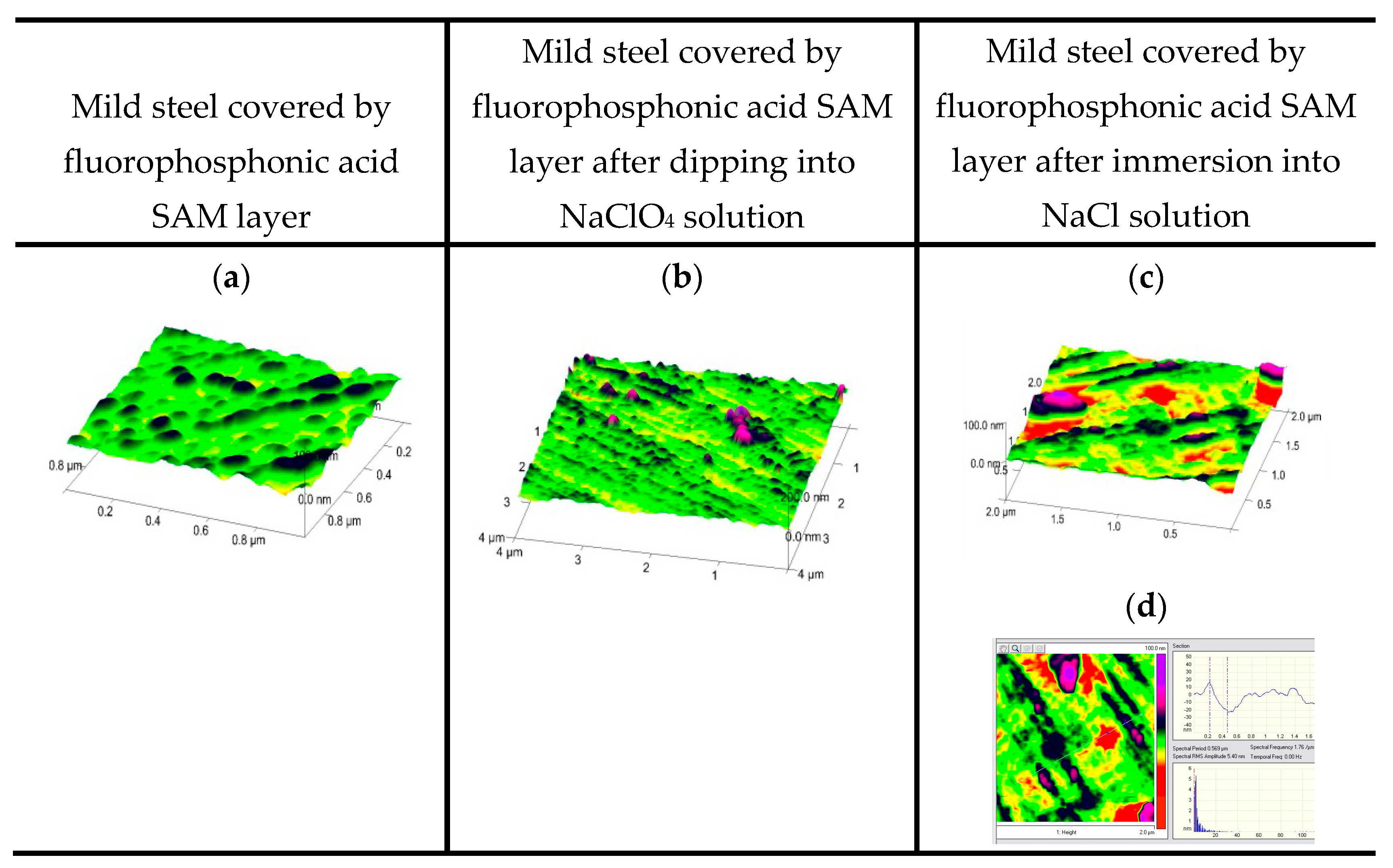

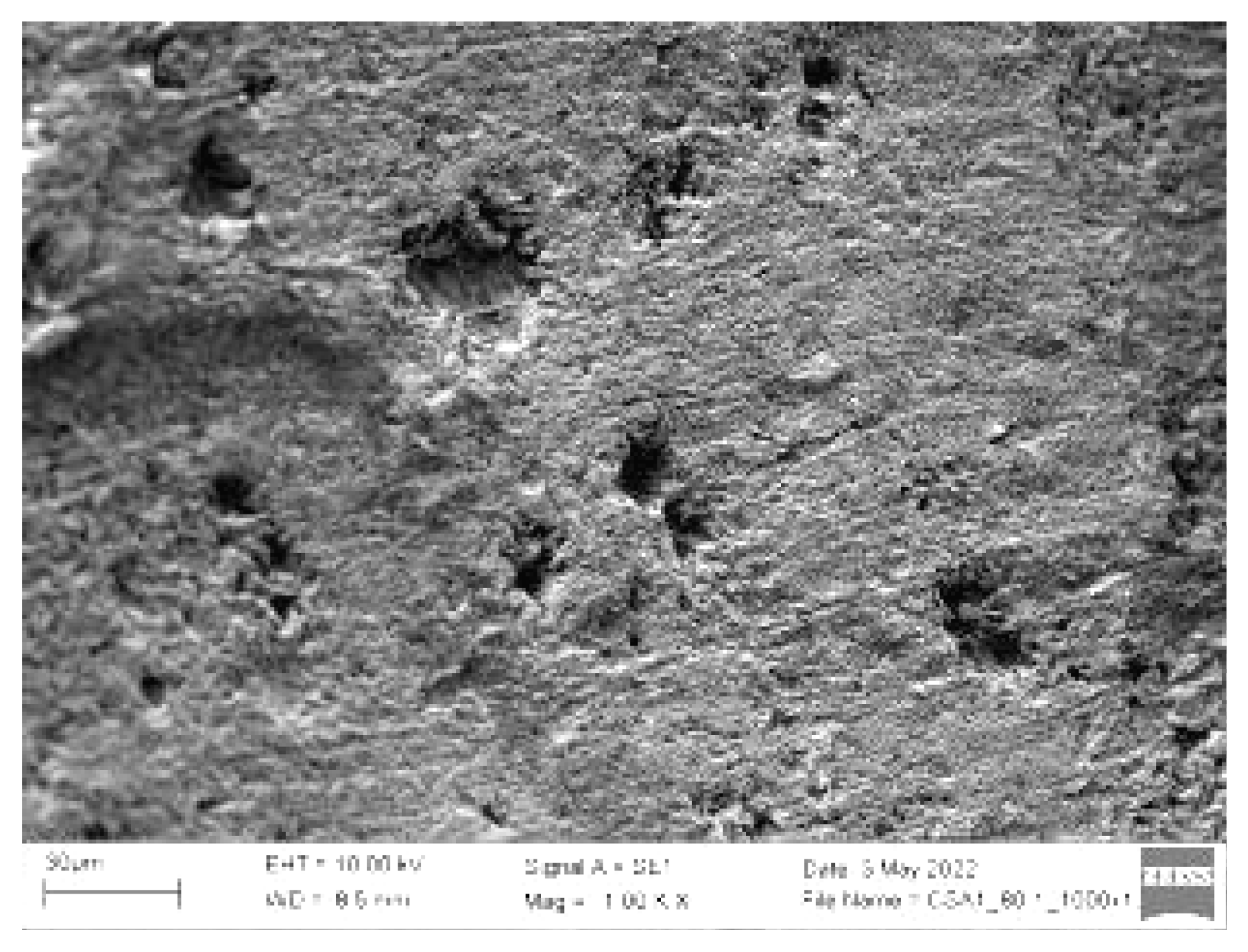



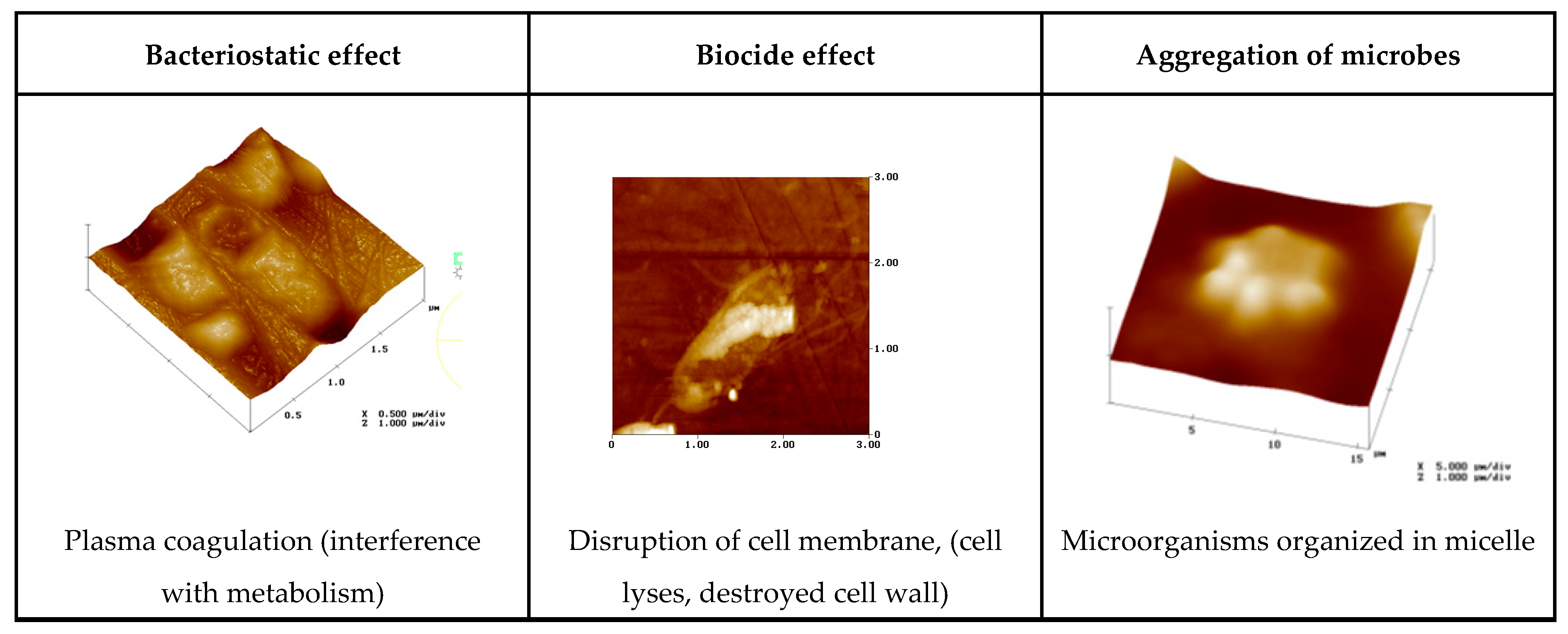
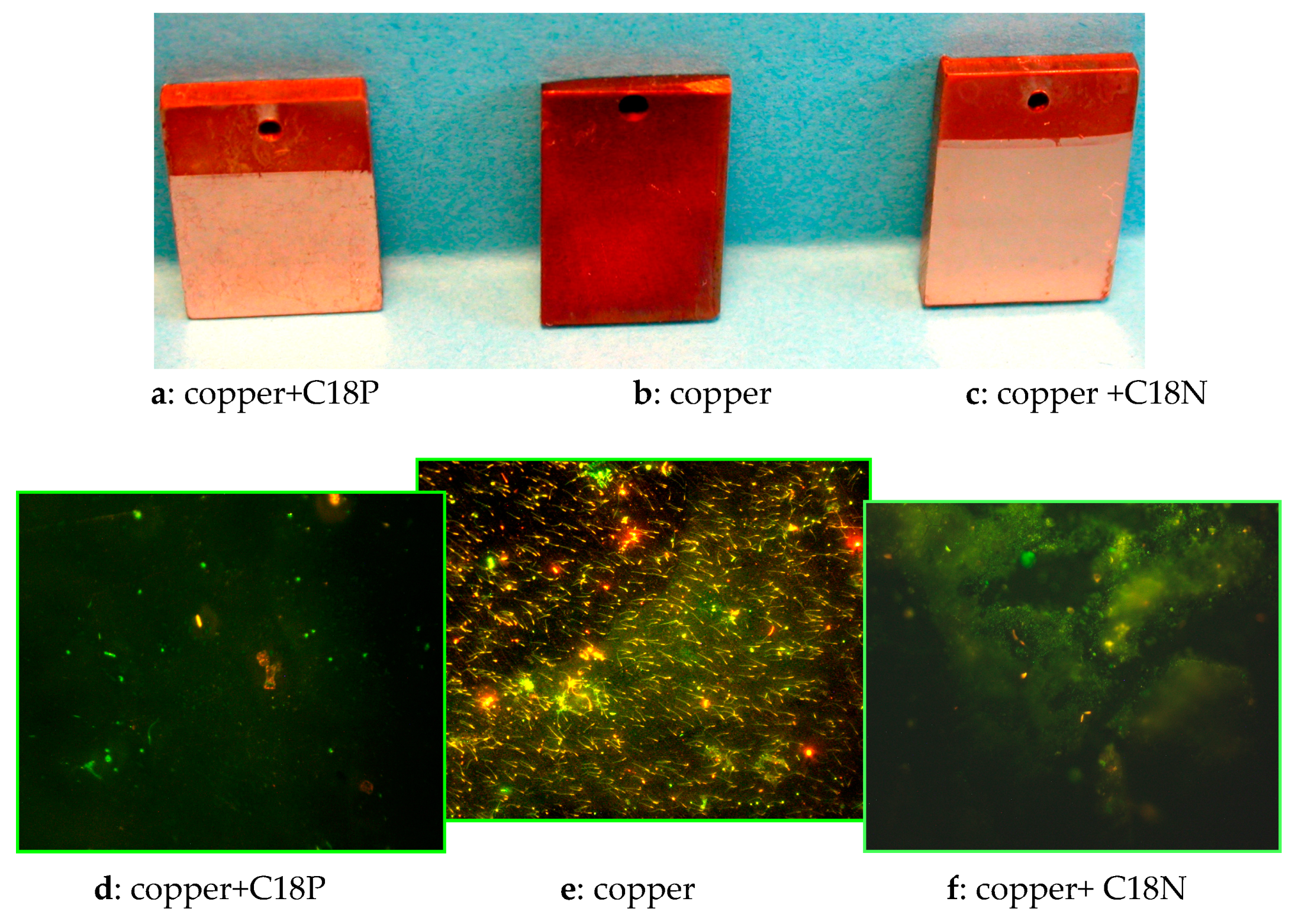
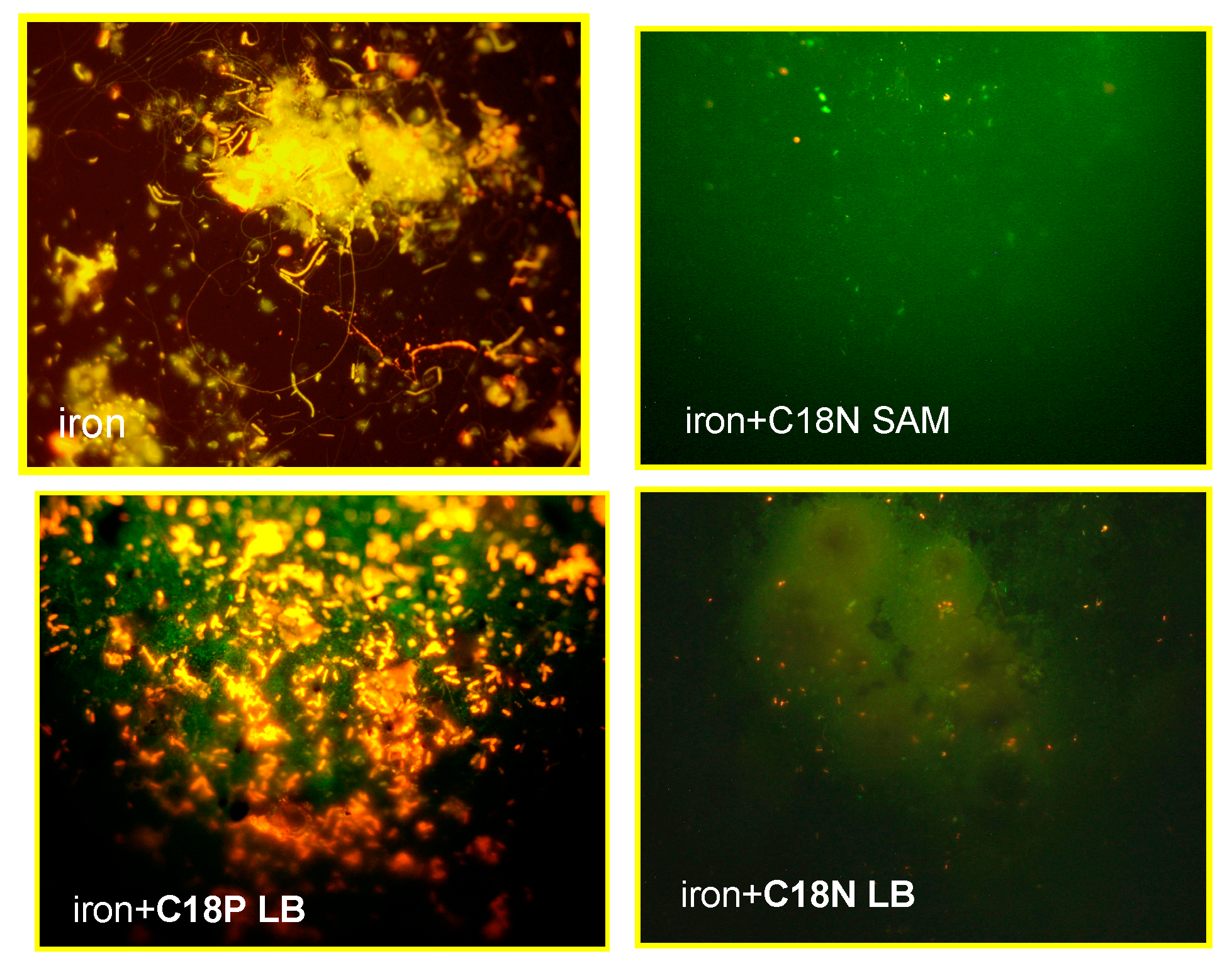
| Time Scale | Important Requirements | Type of Inhibitors |
|---|---|---|
| Before 1970 | Anticorrosion efficiency (the toxicity was not considered as an important factor) | Chromates, phosphates, nitrites, nitrates, silicates, amines |
| 1970–2000 | Anticorrosion efficiency and cost-effectiveness | Phosphates, polyphosphates, phosphonates, molybdates, gluconates, organic molecules with hetero atoms (azoles, triazoles, etc.) |
| 2000– | Not only effectiveness and cost-efficiency, but also the environmentally friendliness | Plant extracts, natural polymers, ionic liquids, combination of organic molecules with metal ions, nanomaterials, nanocomposites |
| Corrosion Monitoring Techniques | Disadvantages | Advantages |
|---|---|---|
| Weight loss measurement | It provides the average corrosion rate and does not allow real-time, continuous monitoring | Simple and cheap technique |
| Visual inspection | It does not give a quantitative measure on the rate of corrosion | Simple, quick method |
| Electrochemical techniques (EIS, polarization, voltammetry) | Only experts can use the instruments and evaluate the results | It informs about the mechanisms and kinetics as well as the type of corrosion |
| Galvanic corrosion technique | The evaluation of the results needs specialists and the measurement goes between dissimilar metals | Simple, applicable for real-time monitoring of corrosion |
| Scanning electron microscopy | It needs a high vacuum; when the surface is not conductive, a surface coating with carbon or gold is necessary; it does not give quantitative results | It allows the surface visualization in much detail; EDX gives precise information on the surface composition |
| Auger electron spectroscopy | The surface charging can disturb the measurement; it needs calibration; the analysis goes in vacuum | It quantitatively analyzes the top of the surface; depth analysis, high spatial resolution |
| Atomic force microscopy | Smooth surface is required | It can work under atmospheric conditions, in liquid, in vacuum; very precise, quantitative surface morphological information |
| X-ray photoelectron spectroscopy | It analyzes only the surface in few nm depth; it works in vacuum; the surface contamination ensures that the atmosphere influences the real results | Information about the elemental composition, it provides the depth profile of components |
| X-ray diffraction | Information about the bulk of the solid is sensitive only to crystals but not to amorphous materials | The corrosion products as crystals are qualitatively and quantitatively analyzed |
| FTIR | The surface needs some preparation; the surface contamination can disturb | It informs about the organic components (coating, inhibitor) and the chemical bonds on the metal surface |
| Microorganisms | pH | Temperature [°C] | Oxygen Demand | Metals under MIC Influence | How Are They Affected? |
|---|---|---|---|---|---|
| Bacteria | |||||
| Desulfovibrio, Desulfomonas | 6–8 | 10–40 | anaerobic anaerobic | Iron and its alloys, Al, Zn, Cu and its alloys | Hydrogen consumption, H2S and metal sulfide production, film formation |
| Thiobacillus thiooxidans | 0.5–8 | 10–40 | aerobic | Iron and its alloys, copper alloys | Sulfuric acid production |
| Thiobacillus ferrooxidans | 1–7 | 10–40 | aerobic | Iron and its alloys | Oxidation of Fe2+ to Fe3+ |
| Gallionella | 7–10 | 20–40 | aerobic | Iron and its alloys | Oxidation of Fe2+ to Fe3+, formation of tuberculum |
| Sphaerotilus | 7–10 | 20–40 | aerobic | Iron and its alloys | Oxidation of Fe2+ to Fe3+, formation of tuberculum |
| Pseudomonas | 4–9 | 20–40 | aerobic | Iron and its alloys | Reduction of Fe3+ to Fe2+ |
| Pseudomonas aeruginosa | 4–8 | 20–40 | aerobic | Al alloys | |
| Fungi | |||||
| Cladosporium resinae | 3–7 | 10–45 | - | Al alloys |
| Time Period | Applied Antifouling Chemicals and Techniques |
|---|---|
| 1500BC–300BC | Pitch, copper plating |
| 400–1860 | Wax, tart, asphalt, train oil, rosin, sulfur, arsenic |
| 1860–2003 | Copper sheathing and heavy metal-based coatings |
| 2003–2011 | Organotin, copper, copper sheathing, coatings with heavy metals |
| After 2005 | Self-polishing coatings with biocides, copper sheathing |
| Additives | Efficiency | ||
|---|---|---|---|
| Bacteria | Fungi | Algae | |
| Chlorine | E | W | E |
| Chloro dioxide | E | G | G |
| Bromine | E | W | E |
| Organic brome compounds | E | - | W |
| methylene-bis-thiocianate | E | W | W |
| iso-thiazolinon | E | G | E |
| Quaterner ammonium salts | E | G | E |
| Organic tin compounds | E | G | E |
| glutare aldehyde, formaldehyde | E | E | E |
| Type of Biocides | Examples | How Do They Affect the Microbial Life? | Results of Biocidal Effect |
|---|---|---|---|
| Oxidizing biocides | hydrogen peroxide, peracetic acid; they are effective in a wide range of pH values | oxidative stress, DNA damage, protein denaturation, enzyme inhibition, lipid peroxidation | Inhibition of metabolic path, cell death |
| organic biocides | glutaraldehyde, isothiazolinones; 2,2-dibromo-3-nitrilopropionamide | cell membrane disruption, protein denaturation, enzyme inhibition, disruption of metabolic pathway, interaction with DNA and RNA | cell death, inhibition of cell growth |
| quaternary ammonium compounds (with long-chain aliphatic groups) | Benzalkonium/cetalkonium chloride, alkyl trimethyl/dodecyl ammonium chloride, dodecylbenzenesulfonic acid | breakdown of the cell membrane, degradation of proteins and nucleic acids, electrostatic interaction, inhibition of ATP synthesis, biofilm disruption | autolytic cell death |
| chlorine-based biocides | sodium hypochlorite, chlorine dioxide, calcium hypochlorite, brome compounds | Inhibition of metabolic reactions/cell growth | cell death |
| Metal-based biocides | Copper- and silver-based molecules | Oxidative damage, protein degradation, leakage of cell membrane | cell death |
Disclaimer/Publisher’s Note: The statements, opinions and data contained in all publications are solely those of the individual author(s) and contributor(s) and not of MDPI and/or the editor(s). MDPI and/or the editor(s) disclaim responsibility for any injury to people or property resulting from any ideas, methods, instructions or products referred to in the content. |
© 2024 by the author. Licensee MDPI, Basel, Switzerland. This article is an open access article distributed under the terms and conditions of the Creative Commons Attribution (CC BY) license (https://creativecommons.org/licenses/by/4.0/).
Share and Cite
Telegdi, J. Multifunctional Inhibitors: Additives to Control Corrosive Degradation and Microbial Adhesion. Coatings 2024, 14, 617. https://doi.org/10.3390/coatings14050617
Telegdi J. Multifunctional Inhibitors: Additives to Control Corrosive Degradation and Microbial Adhesion. Coatings. 2024; 14(5):617. https://doi.org/10.3390/coatings14050617
Chicago/Turabian StyleTelegdi, Judit. 2024. "Multifunctional Inhibitors: Additives to Control Corrosive Degradation and Microbial Adhesion" Coatings 14, no. 5: 617. https://doi.org/10.3390/coatings14050617
APA StyleTelegdi, J. (2024). Multifunctional Inhibitors: Additives to Control Corrosive Degradation and Microbial Adhesion. Coatings, 14(5), 617. https://doi.org/10.3390/coatings14050617







